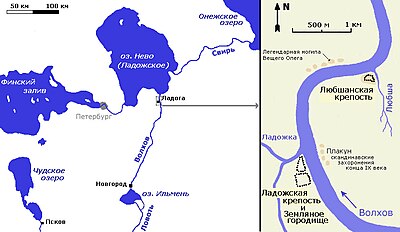| Revision as of 10:29, 17 April 2008 edit84.204.215.139 (talk) Lyubsha was a Slavic fort, not Varangian.← Previous edit | Latest revision as of 01:14, 10 December 2024 edit undoAltenmann (talk | contribs)Autopatrolled, Extended confirmed users, Pending changes reviewers220,255 edits Undid revision 1246084746 by Arkbv2323 (talk) | ||
| (36 intermediate revisions by 24 users not shown) | |||
| Line 1: | Line 1: | ||
| : ''For the Ukrainian military facility, see ].'' | : ''For the Ukrainian military facility, see ].'' | ||
| ] | |||
| ⚫ | '''Lyubsha''' ({{langx|ru|Любша}}) is an archaeological site situated on the right bank of the ], about 1,500 metres downstream from ]. As was determined by the 1997 excavations, Lyubsha is the site of one of the oldest ] fort in ],<ref></ref> established in the first half of the 8th century, thus predating Ladoga. Its layout and dimensions closely resemble the contemporaneous ]s of ]. | ||
| ⚫ | The fortress was destroyed by fire towards the end of the 9th century.<ref>Петренко В.П., Шитова Т.Е. Любшанское городище и средневековые поселения Северного Поволховья. // Средневековая Ладога. Leningrad, 1985.</ref> ] connects its destruction with a conflict (]'s uprising) that marked the downfall of the ].<ref>Zuckerman C. ''Deux étapes de la formation de l’ancien état russe,'' dans ''Les centres proto-urbains russes entre Scandinavie, Byzance et Orient. Actes du Colloque International tenu au Collège de France en octobre 1997,'' éd. M. Kazanski, A. Nersessian et C. Zuckerman (Réalités byzantines 7), Paris 2000, p. 95-120.</ref> The Norse name of Lyubsha is unknown. | ||
| ⚫ | '''Lyubsha''' ( |
||
| ⚫ | The fortress was destroyed by fire towards the end of the |
||
| Immediately north of Lyubsha lies the village of Gorchakovshchina, which used to be a trading post at the head of navigation on the Volkhov, near its ancient entry into ]. ] ranks it, along with Ladoga and ], among the most important centres of the khaganate.<ref>Мачинский Д.А. О роли финноязычного населения бассейнов Волхова и Великой в сложении этносоциума "Русь" (VIII-XI вв.) // Современное финноугроведение. Опыт и проблемы. Leningrad, 1990.</ref> | Immediately north of Lyubsha lies the village of Gorchakovshchina, which used to be a trading post at the head of navigation on the Volkhov, near its ancient entry into ]. ] ranks it, along with Ladoga and ], among the most important centres of the khaganate.<ref>Мачинский Д.А. О роли финноязычного населения бассейнов Волхова и Великой в сложении этносоциума "Русь" (VIII-XI вв.) // Современное финноугроведение. Опыт и проблемы. Leningrad, 1990.</ref> | ||
| Line 11: | Line 11: | ||
| {{Gardariki}} | {{Gardariki}} | ||
| {{coord|60.0000|N|32.3167|E|source:wikidata|display=title}} | |||
| ] | ] | ||
| ] | ] | ||
| ] | ] | ||
| ] | |||
| ] | |||
| ] | |||
Latest revision as of 01:14, 10 December 2024
- For the Ukrainian military facility, see Lyubsha (air base).

Lyubsha (Russian: Любша) is an archaeological site situated on the right bank of the Volkhov, about 1,500 metres downstream from Staraya Ladoga. As was determined by the 1997 excavations, Lyubsha is the site of one of the oldest Slavic fort in Russia, established in the first half of the 8th century, thus predating Ladoga. Its layout and dimensions closely resemble the contemporaneous hill forts of Great Moravia.
The fortress was destroyed by fire towards the end of the 9th century. Constantine Zuckerman connects its destruction with a conflict (Vadim's uprising) that marked the downfall of the Rus' Khaganate. The Norse name of Lyubsha is unknown.
Immediately north of Lyubsha lies the village of Gorchakovshchina, which used to be a trading post at the head of navigation on the Volkhov, near its ancient entry into Lake Ladoga. Dmitry Machinsky ranks it, along with Ladoga and Alaborg, among the most important centres of the khaganate.
References
- Articles about Lyubsha fortress
- Петренко В.П., Шитова Т.Е. Любшанское городище и средневековые поселения Северного Поволховья. // Средневековая Ладога. Leningrad, 1985.
- Zuckerman C. Deux étapes de la formation de l’ancien état russe, dans Les centres proto-urbains russes entre Scandinavie, Byzance et Orient. Actes du Colloque International tenu au Collège de France en octobre 1997, éd. M. Kazanski, A. Nersessian et C. Zuckerman (Réalités byzantines 7), Paris 2000, p. 95-120.
- Мачинский Д.А. О роли финноязычного населения бассейнов Волхова и Великой в сложении этносоциума "Русь" (VIII-XI вв.) // Современное финноугроведение. Опыт и проблемы. Leningrad, 1990.
| Garðaríki | ||
|---|---|---|
| Names in italics are settlements whose Norse names are not recorded | ||
| Volkhov-Volga trade route |  | |
| Dvina-Dnieper trade route | ||
| Other locations | ||
60°00′00″N 32°19′00″E / 60.0000°N 32.3167°E / 60.0000; 32.3167
Categories: